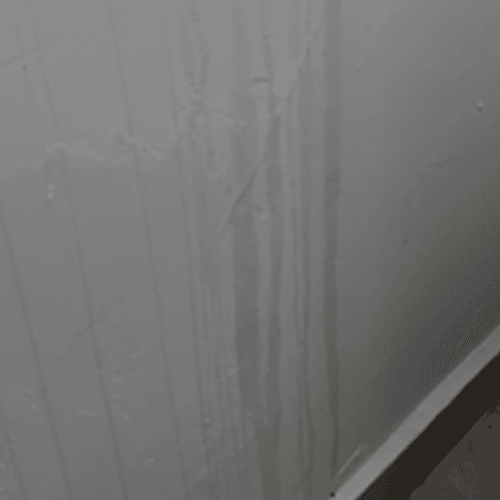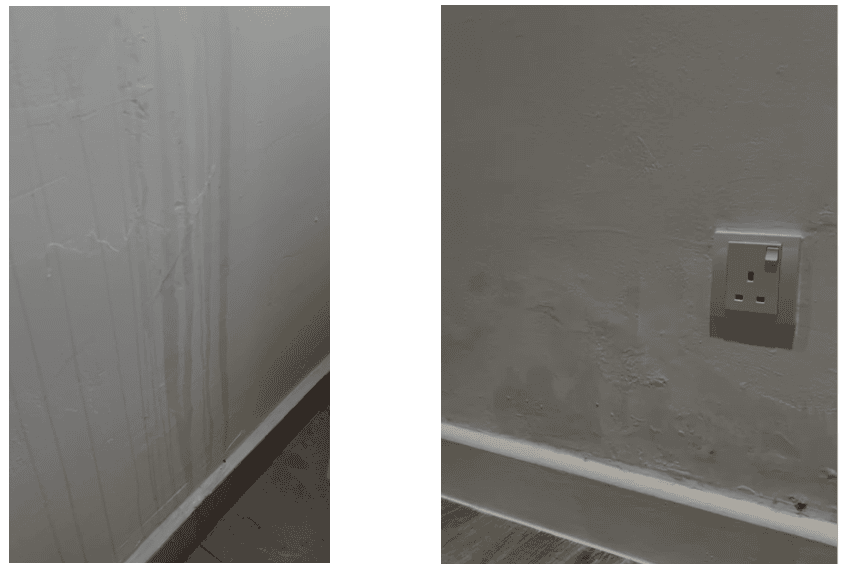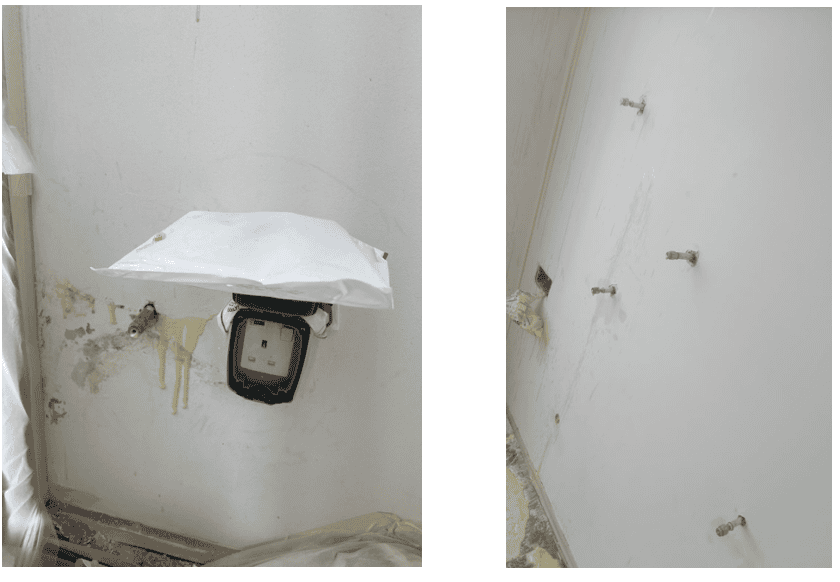In the bustling city of Singapore, where humidity and rainfall are common occurrences, homeowners often face challenges related to water damage and stains on their walls, especially in areas like bathrooms and kitchens. Understanding why water stains appear on walls is crucial for effective waterproofing and maintenance. In this comprehensive guide, we’ll delve into the causes of water stains, signs of water damage, removal methods, and how to prevent future watermarks on your walls.
Water stains on walls serve as a significant indicator of water damage, there is a need to investigate the source of water infiltration. Typically, such stains indicate a waterproofing leak, although other factors may also contribute. These issues may originate from external sources beyond your home’s interior.
Why are there watermarks on the walls?
Watermarks on walls are typically caused by water seepage or leakage from various sources. Common culprits include:
- Rainwater Seepage:
External factors like heavy rains can also contribute to water stains on walls. If walls are not adequately waterproofed or if there are gaps or cracks through which water can enter, rainwater can seep through and cause stains. Ensuring proper waterproofing of exterior walls and maintaining gutters and downspouts to redirect rainwater away from the walls can mitigate this issue.
- Leaky Pipes:
Leaky pipes are a common cause of water stains on walls. Pipes that are damaged, corroded, or improperly installed can leak water onto nearby walls, leading to visible watermarks and potential structural damage. It’s essential to inspect plumbing systems regularly and repair any leaks promptly to prevent further water damage.
- Condensation:
In humid environments like Singapore, condensation can occur on walls, especially in areas with poor ventilation such as bathrooms. When warm, moist air comes into contact with cooler surfaces, it can condense and form water droplets, causing water stains over time. Improving ventilation through exhaust fans or dehumidifiers can help reduce condensation and minimize water stains.
Water stains on walls are often indicative of water seepage or leakage. It’s important to address these stains promptly to prevent further damage to the walls and potential structural issues.
Signs of water damage in walls include:
- Discoloration or water stains
- Peeling or bubbling paint
- Warped or damaged drywall
- Musty odors
- Mold or mildew growth
Water damage can occur due to various reasons, such as:
- Poor waterproofing during construction or renovations
- Aging plumbing systems
- Harsh weather conditions causing water intrusion
- Improper ventilation leading to condensation build-up
Water damage can lead to serious consequences if not addressed promptly. These may include:
- Structural weakening of walls and ceilings
- Mold and mildew growth, impacting indoor air quality
- Damage to electrical systems if water reaches wiring
- Compromised integrity of the building’s foundation
What causes the water stains to appear on the wall?
Water stains on walls can appear due to various factors related to water infiltration and absorption into wall materials. Understanding these causes can help in effectively addressing and preventing water stains. Here are the primary reasons why water stains may appear on walls:
- Roof Leaks:
If a roof has leaks or poor waterproofing, rainwater can seep through and reach interior walls, causing water stains. This is particularly common during heavy rainfall or when roofs are damaged.
- External Water Sources:
Water can also enter walls from external sources such as improper drainage, landscaping, or irrigation systems. If water pools near exterior walls or seeps through cracks, it can cause stains and water damage indoors.
- Poor Waterproofing:
Insufficient waterproofing of walls during construction or renovations can make them vulnerable to water penetration. Without proper protection, water can easily seep through porous materials and leave stains.
- Flooding or Water Intrusion:
In cases of flooding or water intrusion from heavy rains, water can enter homes and cause extensive water stains on walls, particularly in basements or lower levels.
- Foundation Issues:
Cracks or gaps in the foundation of a building can allow water to enter and travel upwards, leading to water stains on lower portions of walls.
- Leaky Plumbing:
One of the most common causes of water stains is leaky plumbing. This includes pipes, faucets, toilets, and other plumbing fixtures that may develop leaks over time. The water from these leaks can seep into walls, leading to visible stains and damage with no leakage source.
- Condensation:
High humidity levels, especially in areas like bathrooms and kitchens, can lead to condensation on walls. When warm, moist air comes into contact with cooler wall surfaces, condensation occurs, leaving behind water stains over time.
- Appliance Leaks:
Appliances such as washing machines, dishwashers, and water heaters can develop leaks, especially if they are old or not properly maintained. Water from these leaks can penetrate walls and create stains.
- Air Conditioning System Issues:
Air conditioning systems can sometimes leak water, especially if there are issues with drainage or condensation lines. This water can find its way into walls and result in stains.
Addressing these potential causes requires a thorough inspection of the property to identify the source of water infiltration. Once the source is identified, appropriate repairs, waterproofing measures, and maintenance can be implemented to prevent future water stains and damage.
How to stop watermarks on the walls?
Prevent watermarks on walls by:
- Regularly inspecting plumbing systems for leaks and repairing them promptly.
- Installing proper ventilation in bathrooms and kitchens to reduce humidity levels.
- Applying waterproof coatings or sealants on walls to prevent water penetration.
- Maintaining gutters and downspouts to redirect rainwater away from the walls.
Who to look for in solving the water seepage on the wall?
When dealing with water seepage issues, consider contacting:
- Licensed Waterproofing Contractors: Professionals specializing in waterproofing solutions for homes and buildings.
- Waterproofing Specialists: Experts who can assess the extent of water damage and recommend effective repairs.
- Experienced Contractors: Look for contractors with a track record of successfully resolving water seepage problems.
Professional waterproofing contractors employ specialized techniques and methods to repair water seepage on walls effectively.
- Initial Assessment and Diagnosis:
- The first step is to conduct a comprehensive property assessment to identify areas of water seepage and determine the underlying causes.
- This assessment may involve using moisture meters, thermal imaging cameras, and visual inspections to pinpoint areas with water infiltration.
- Source Identification and Repair:
- Once the sources of water seepage are identified, such as cracks, gaps, or faulty waterproofing, contractors proceed to repair these issues to stop water ingress.
- Common repair methods may include sealing cracks in walls or foundations, repairing damaged waterproofing membranes, and addressing drainage problems around the property.
- Surface Preparation:
- Before initiating repair work, contractors ensure that the affected wall surfaces are properly prepared. This may involve cleaning the walls to remove dirt, debris, and existing mold or mildew.
- They may also use mold remediation treatments or antimicrobial solutions to eliminate mold growth and prevent its recurrence.
- Waterproofing Solutions:
- Professional contractors utilize advanced waterproofing solutions and materials to create a durable barrier against water seepage.
- This may involve applying waterproof membranes, coatings, or sealants to vulnerable areas such as basement walls, foundation walls, or exterior walls exposed to heavy rainfall.
- Crack Injection and Grouting:
- In cases of cracks in concrete or masonry walls, contractors may use injection grouting techniques to fill and seal these cracks effectively.
- Polyurethane (PU) injection grouting or epoxy injection are commonly used methods to restore the structural integrity of walls and prevent water seepage through cracks.
- Interior Waterproofing Measures:
- In addition to exterior waterproofing, contractors may implement interior waterproofing measures to protect basement walls and lower levels from water seepage.
- This may include installing interior drainage systems, sump pumps, and moisture barriers to manage groundwater and prevent moisture intrusion.
- Quality Assurance:
- After completing the repair and waterproofing work, contractors conduct thorough quality assurance checks to ensure that water seepage issues have been effectively resolved.
By following these detailed steps and utilizing advanced waterproofing techniques, professional contractors can effectively repair water seepage on walls, protect properties from water damage, and ensure long-lasting waterproofing solutions.
Polyurethane (PU) injection grouting is a specialized waterproofing method commonly used by professional contractors to repair cracks, voids, and leaks in concrete structures, including walls, floors, and foundations. This method involves injecting polyurethane resin into the affected areas to fill gaps, seal cracks, and create a watertight barrier.
Before initiating PU injection grouting, the contractor conducts a thorough assessment of the concrete structure to identify cracks, voids, or areas of water seepage. The polyurethane resin is prepared according to manufacturer specifications, typically involving mixing resin components to activate the foaming and expansion properties.
The prepared resin is then injected into the injection ports under controlled pressure using specialized injection equipment. The pressure is adjusted based on the depth and width of the crack or void.
As the resin is injected, it expands and fills the cracks and voids, adhering to the concrete surfaces and creating a tight seal against water infiltration.
Polyurethane resins used in injection grouting have foaming and expansion capabilities, allowing them to penetrate deep into cracks and voids while creating a durable and flexible seal.
The expansion of the resin helps to close off pathways for water seepage and reinforces the structural integrity of the repaired area.
After injection, the polyurethane resin cures and sets within a relatively short time, forming a resilient and impermeable barrier against water ingress.
The curing process may vary depending on the resin formulation and environmental conditions but generally occurs within a few hours.
Once the resin has fully cured, any excess or protruding resin is trimmed or removed from the surface to achieve a smooth and flush finish.
After completing the PU injection grouting process, the repaired areas are inspected for quality assurance. This may include visual checks to ensure effective sealing and waterproofing.
PU injection grouting offers several advantages, including rapid curing times, high flexibility, excellent adhesion to concrete surfaces, and water and chemical penetration resistance.
It is a cost-effective and efficient method for repairing cracks and waterproofing concrete structures without extensive excavation or disruption to the building.
By utilizing PU injection grouting, professional contractors can effectively repair water seepage, strengthen concrete structures, and provide long-lasting waterproofing solutions for various applications.
When searching for the finest waterproofing specialist in Singapore, it’s crucial to consider the valuable insights provided. Effective waterproofing extends beyond fixing visible leaks; it involves a proactive strategy to protect your property from Singapore’s unique climate challenges.
At SWC Construction, we are a reputable and reliable contractor specializing in waterproofing. Our commitment is to provide the best waterproofing solutions to our valued clients. Our team comprises highly skilled technicians and consultants dedicated to delivering flawless workmanship. We use premium and efficient waterproofing materials tailored to meet our client’s specific needs.
Feel free to contact us today for a seamless and efficient waterproofing solution to resolve those troublesome leaks. With our experienced team, we are well-equipped to handle necessary repair work. Additionally, we offer on-site consultations to address and alleviate any concerns homeowners may have regarding toilet water leaks.





